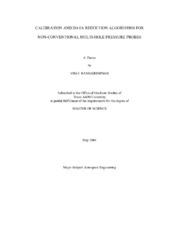| dc.description.abstract | This thesis presents the development of calibration and data-reduction algorithms for non-conventional multi-hole pressure probes. The algorithms that have been developed for conventional 5- and 7-hole probes are not optimal for probes with port arrangements (on the probe tip) that are non-conventional. Conventional algorithms utilize the axisymmetry of the port distribution pattern to define the non-dimensional pressure coefficients. These coefficients are typically defined specifically for these patterns, but fail to correctly represent different patterns of port arrangements, such as patterns without axisymmetry or regularity. The algorithms introduced herein can handle any pattern of port arrangement, from axisymmetric and regular to random. Moreover, they eliminate the need to separate the measurement domain of a probe to "low-angle" and "high-angle" regimes, typical in conventional 5- and 7-hole-probe algorithms that require two different sets of pressure coefficient definitions and procedures. Additionally, the algorithms have been formulated such that they facilitate redundancy implementations, especially in applications where such redundancy is important, such as air-data systems. The developed algorithms are first applied to a non-conventional probe, a nearly omni-directional 18-hole probe, and demonstrate very high flow measurement accuracy. Subsequently, the algorithms were applied to a new 12-hole, nearly omni-directional, flow velocity measurement probe capable of measuring reversed flows. The new 12-hole design offers several advantages over a previously developed, 18-hole, nearly omni-directional probe. The probe is optimized in the sense that, regardless of the flow direction, it allows calculation of the 4 unknown flow quantities, i.e. the two flow angles, the velocity magnitude and the static pressure, with the minimum necessary number of holes/ports on the probe tip. This probe also has a non-conventional arrangement of its pressure ports and therefore the new calibration and data-reduction algorithms can be effectively employed. With theoretically generated pressure data for the 12-hole probe, the coefficient definitions are analyzed and found to be well-behaved. | en |


